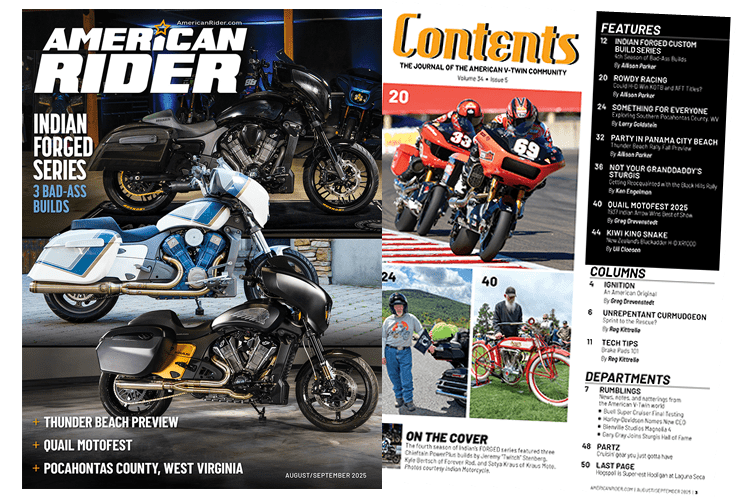Having been interested in motorcycles for the last 300 years I have read every book, magazine and brochure on the subject, seen every film and I can sing the words to Arlo Guthrie’s “Motorcycle Song.” “I don’t want a pickle, just want to ride my motor… sickle.”
OK, it hasn’t been 300 years, and no, I haven’t read every word on the subject or seen every movie. However, I have owned a ton of two-wheeled conveyances and the excuse and justification for most of these purchases were their published specifications. Yes, I am a specification freak.
In 1969, Cycle World magazine published an article on the Norton Commando Production Racer. They tested it at two Southern California racetracks, Orange County International Raceway and Riverside International Raceway, neither of which exists today. Reading the article, I turned the pages and perused the spec sheet. Horsepower: 66 @ 7000 rpm, curb weight: 420 pounds, top speed: 131.02 mph, list price… N/A. They declared, “The Commando is thus the fastest ‘production’ machine ever tested by Cycle World.”
Oh yeah! I need one of these. Problem was the price for the production racer was not available because the bike was not available. Available or not, I still needed one and was incapable of sleep for more than a week. A year later I bought a stock Norton Commando and it was way more than I needed; not more than I wanted, but more than I needed. I still own the bike.
In 1971, Ducati motorcycles started becoming interesting. In the Cycle World road test of the Ducati 750 V-twin the central description was, “The 90-degree V-twin is basically two 350 Ducati singles lashed together.” That clarification was mandatory because today everyone knows that a Duck is a terror on a road course, but back then all anyone had ever seen was the 350 singles. Later in the article they went on to talk about helical-cut bevel gears and towershafts, winkler caps, wet sumps, Grimeca brakes, built-in cush-hubs, side covers with Flash Gordon air-scoops, etc., etc., etc. (Flash Gordon? Go ask your mother.)
The descriptions and specifications went on for pages and sounded like a shop manual. I understood less than 30 percent. But that was OK. I was sure I needed one. I needed one right up to the place where it said $1,995. My God, that was an additional $700 more than I just paid for my Norton.
I never owned a Ducati, but I got really close several years later, in 1986 when the Ducati 750 Paso was introduced. Without too much pretense it looked and smelled like a two-wheeled Ferrari. Faired from stem to stern, it was probably the first production bike that sported totally enclosed bodywork. (No, I don’t count the Vincent Black Prince.) Motorcyclist magazine said, “A Ducati that bridges the gap between true Italian exotica and real-world usefulness.” Wet weight: 462 pounds, claimed horsepower: 72 @ 7900 rpm, top speed: 131 mph. All this and desmodromic valves for a mere $5,800! $5,800; are you guys kidding?
One hundred and thirty one mph; wasn’t that the same as the 1969 Norton Production Racer? I checked my historical specification files. Yep, that’s what I thought; it’s the same. Crazy Italians; they really have a great sense of humor.
For a period of about 10 years I bought and repaired junk motorcycles and sold them as antiques. Old English bikes were cheap, and as strange as it may sound I understood Amal carburetors and Lucas electrics. That was something the riders who turned Triumphs, BSAs and Ariels into crap didn’t know. I made the bikes roadworthy, turned a slight profit and paid the rent.
A person might think that by doing this I would have a couple of bucks in the bank. No. Reading spec sheets religiously and being a man of easy virtue, every so often lust would overcome me and I would succumb to a shiny new motorcycle. Like a marijuana lover who buys a kilo and sells off some so he can smoke for free, I worked on the junkers and antiques to pay for my habit. At one time, counting the projects and the currently registered bikes, I had 17 units in a one-car garage. Yeah, yeah, I know; don’t say it.
But then something odd happened. With no explanation and without consulting a specification sheet of any kind I bought a Harley Electra Glide. Compared to everything else I owned it was a pickup truck. I found something that was not on a specification sheet. It was fun to ride, didn’t beat me up over a long distance and it was red.
Now that I owned one, I started comparing spec sheets on different Harley-Davidson models. But that was a waste of time and would make you crazy because they only made two different engines. Your options were the color of the tank and the type of wheels.
New riders don’t care about specifications. They don’t want to evaluate different models or weigh one brand against another. People want the fast and easy answer. They ask me, “You have lots of bikes. Which one is best?”
I reply with a simple question, “How do you want to ride it and what experience do you have?”
To the innocent new buyer I usually suggest a secondhand midsize Japanese metric cruiser. Used, with little or no mileage on them, they have already terrified the original owners and for chump change you can pick one up from an uncompromising wife who has laid the law down to a sheepish husband.
More often than not the new buyer’s response is, “But I want to buy a Harley. I want to know about Harleys.”
I should know better, and I am reminded of the old quote, “You can’t sell a motorcycle to a person who wants to buy a Harley, and you can’t sell a Harley to a person who wants to buy a motorcycle.”
So be it. Consequently, realizing that these greenhorns have wax in their ears, I no longer suggest the reading of spec sheets and have given up advising that they should analyze anything.
“Just go into the dealership, ask for a salesman and buy the red one.”


















